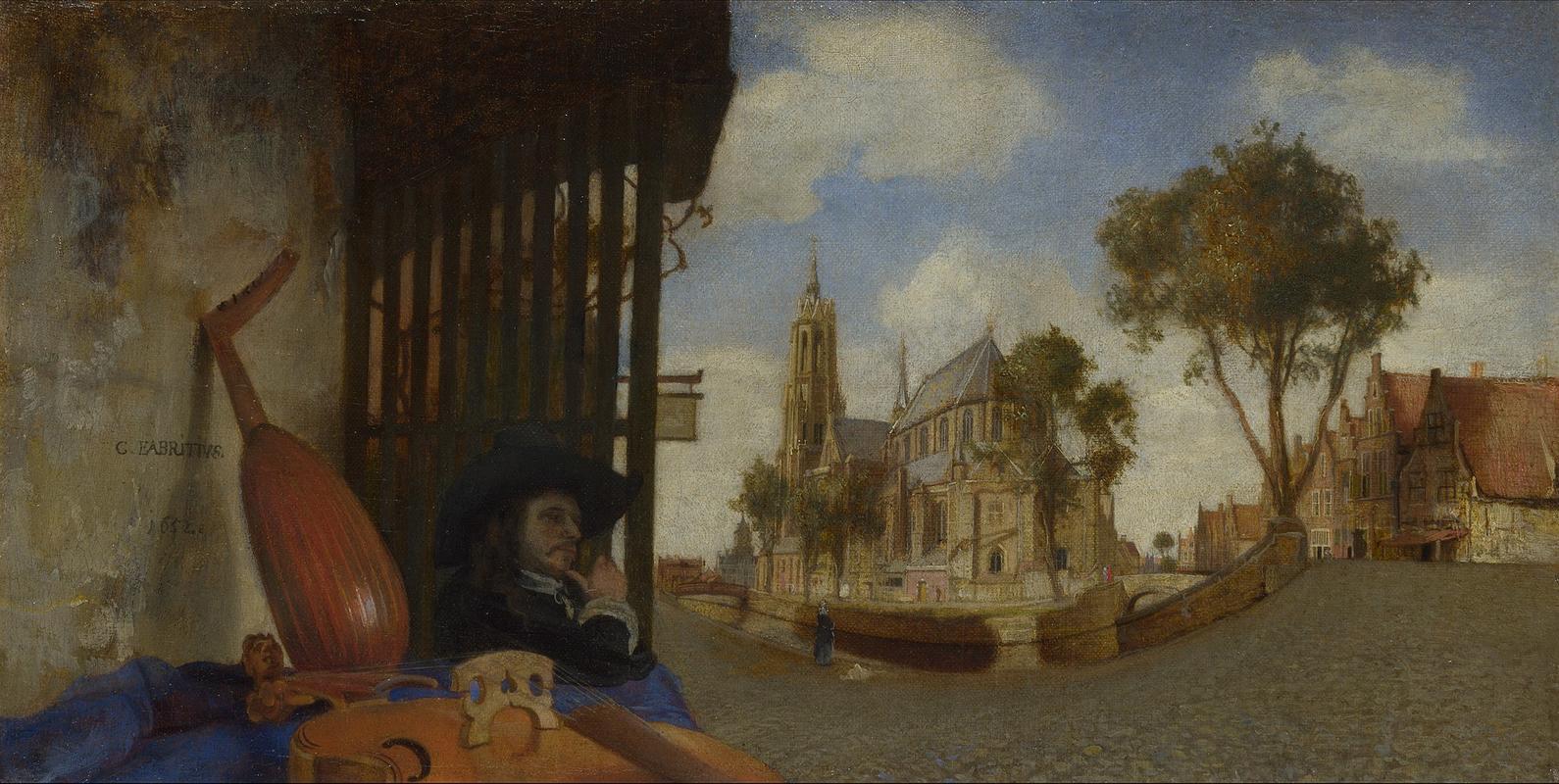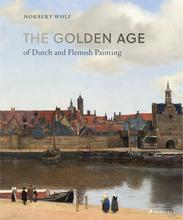More about A View of Delft, with a Musical Instrument Seller's Stall
- All
- Info
- Shop

Sr. Contributor
There aren’t a lot of paintings by Carel Fabritius that are around for us to see today, as he died at the age of 32 from a huge gunpowder magazine explosion in the town of Delft, thus cutting his career short.
The explosion destroyed a good portion of the city, as well as Fabritius’ studio and most of his paintings. Fabritius studied under Rembrandt at his studio in Amsterdam in the early 1640s and is probably best known for his painting, The Goldfinch, which was featured in a novel that has now been made into a movie.
This work is notable for its small size, approximately 12 ½” x 6,” and for its odd perspective; almost as if it were viewed through a wide-angle or fish-eye camera lens. A View of Delft, (full title: A View of Delft, with a Musical Instrument Seller's Stall), is currently displayed at the National Gallery, London.
The reason for the unusual perspective is that it was probably meant to be mounted and viewed through a “perspective box,” in which the painting itself would be curved inside the box and seen through a hole in the front. From this viewpoint, the painting would not look as strange as it does; it might even have a somewhat three-dimensional look to it, at least that was the idea behind this concept. These types of paintings, when mounted in their boxes, were also called “peep shows,” and were primarily a Dutch thing. Not the type of peep show most of us think of when hearing that, but hey, we’re talking 17th century Dutch here.
Unfortunately, we are not able to see exactly what it would look like from that view, since it is now mounted flat at the museum, for practical reasons. If we could, however, we might feel as if we were inside the stall with the gentleman selling the instruments, while looking out toward the Nieuwe Kerk (which is still there). In a few examples of the 17th century perspective boxes that exist today, there is an additional painting on the bottom and/or sides to further the 3-D effect; it is unknown if there were any other parts to A View of Delft.
No matter how it was meant to originally be viewed, it is a unique and rare example of a form of Dutch painting that is still raising questions among museum visitors, conservators, and art historians. Who knows, it’s highly unlikely, but maybe the perspective box that this painting was meant to be mounted in will be discovered in someone’s attic in Delft, and the questions regarding this painting can finally be answered.
Sources
- Fabritius, Carel. “Carel Fabritius: A View of Delft: NG3714: National Gallery, London.” The National Gallery, January 1, 1970. https://www.nationalgallery.org.uk/paintings/carel-fabritius-a-view-of-….
- Larry Keith. 1994. “Carel Fabritius’ ‘A View in Delft’: Some Observations on Its Treatment and Display.” National Gallery Technical Bulletin 15: 54. http://0-search.ebscohost.com.pacificatclassic.pacific.edu/login.aspx?d…
- Magda Michalska. “The Explosive Life and Death of Carel Fabritius” May 16, 2018 https://www.dailyartmagazine.com/explosive-life-and-death-of-carel-fabr…
- “Perspective Box of a Dutch Interior.” Home. Accessed September 25, 2019. https://www.dia.org/art/collection/object/perspective-box-dutch-interio….
- “The Dutch Peep Show.” The Dutch Peep Show. Accessed September 19, 2019. http://art-now-and-then.blogspot.com/2017/04/the-dutch-peep-show.html.
Featured Content
Here is what Wikipedia says about A View of Delft
A View of Delft, with a Musical Instrument Seller's Stall is a 1652 painting by Carel Fabritius. It is an oil painting on canvas of 20.9 by 35.7 cm (8.2 by 14.1 in) of a cityscape of Delft. The work has been in the collection of the National Gallery in London since 1922. The unusual perspective distortion, especially visible to the right of the church, suggests that it may have been intended to have been displayed on a curved surface at the back of a perspective box (and viewed through a peephole,) hence making an illusion of anamorphosis. Fabritius is mentioned in contemporary documents in connection with perspective boxes. The view is of the Nieuwe Kerk facing the Town Hall and several houses, one of which is still extant, at the point where the Oude Langendijk canal meets the Vrouwenrecht. The size of the canvas, exceptionally small for a cityscape of its kind, also supports the perspective-box hypothesis. Another possibility is that Fabritius designed the picture with the aid of a double-convex lens, as these may create distorted proportions in a pattern akin to those seen in the painting. However, material analyses carried out during conservation strengthen the possibility of the perspective-box view.
It is likely that the body of the viol at bottom left would have been completed by a separate painted piece within the perspective box. Walter Liedtke suggests that the resulting composition, viewed from the peephole, would have made the viol and the choir of the Nieuwe Kerk approximately the same size, thus juxtaposing the sacred space of the church with the world of the senses represented by the musical instruments. The lute, one of which is depicted to the left of the instrument seller, commonly appeared in treatises on perspective, such as that of Albrecht Dürer as a demonstration of how to project irregular, rounded shapes onto flat surfaces; thus it may demonstrate a certain self-awareness of technical skill by the painter. The Nieuwe Kerk in Delft is also notable for containing the tomb monuments of William the Silent and later Princes of Orange; the church was therefore a site with distinct political meaning in the 17th century and thereafter.
Check out the full Wikipedia article about A View of Delft













